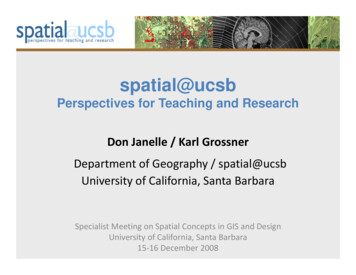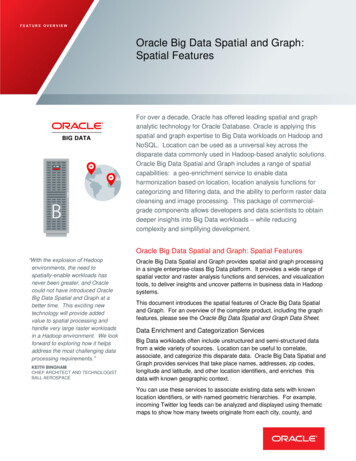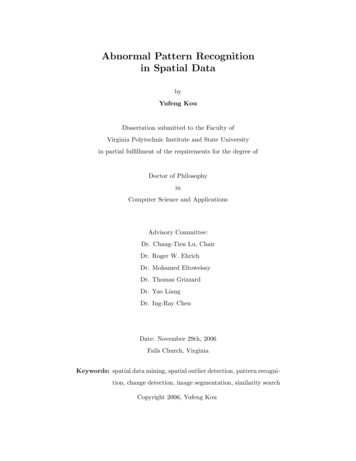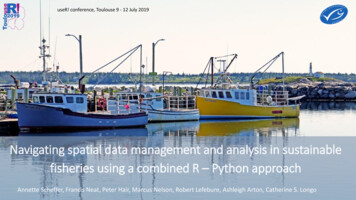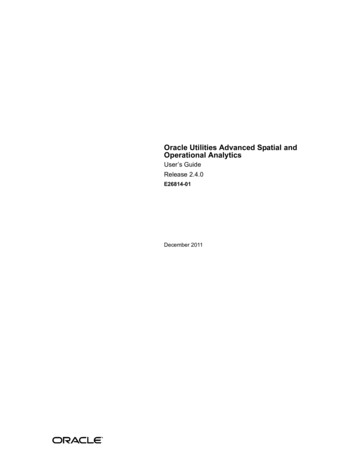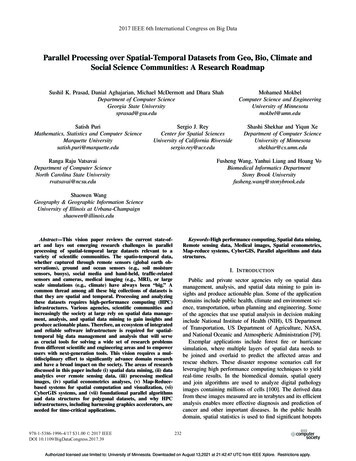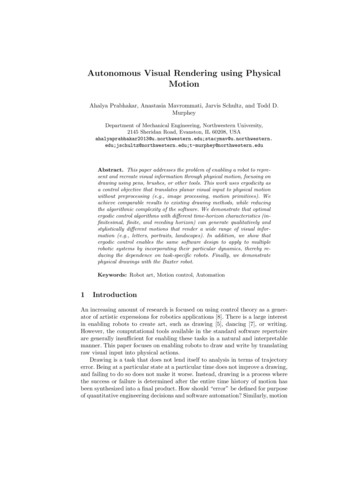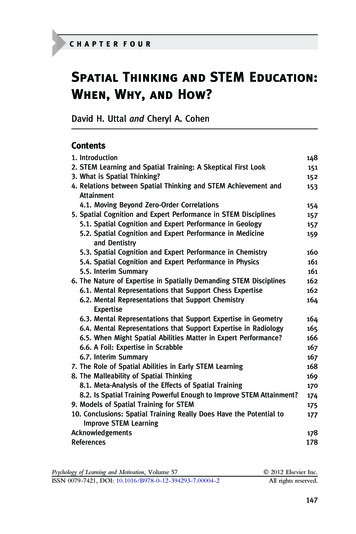
Transcription
Jung Min JANG / Journal of Distribution Science 19-2 (2021) 53-6453Print ISSN: 1738-3110 / Online ISSN 2093-7717JDS website: s.19.2.202102.53Spatial Distance Effect in Shaping Perceived Similarity of Products inthe Online StoreJung Min JANG1Received: December 31, 2020. Revised: January 16, 2020. Accepted: February 05, 2021.AbstractPurpose: Even though arranging images of products is a common practice in the online retail context, relatively little attention has beenpaid to the distance effect among alternatives, that is, how distance among displayed products can impact consumers’ responses.Drawing on contagion theory, the primary goal of the current study is to investigate how spatial distance between two products in aproduct display can influence consumers’ perceived similarity. Research design, data and methodology: This study used a 2(spatialdistance: close vs. far) experimental design and collected data from undergraduate students in Korea through an online survey usingQualtrics. ANOVA was conducted to test the proposed effect, in which the dependent variables are the perceived similarity of usageoccasion/purpose (Study 1) and the indexed differences of perceived brand statuses between two products (Study 2). Results: Theresults of both experiments indicated that the displayed products were perceived to be more similar to one another when products werepresented close together (vs. far). Conclusions: The results help to fill a research gap and provide a better understanding of the role ofphysical distance in diverse marketing communications. This is especially useful when designing online shopping websites to formperceptions of brand images.Keywords : Product Display, Spatial Distance, Perceived Similarity, Usage Occasion, Perceived Brand StatusJEL Classification Code: L19, L81, M30, M311. Introduction12The global pandemic has made online shopping adominant way to purchase products (i.e., Lee & Kim, 2020;Wang & Zhang, 2020). According to Statista (2020),approximately 88% of the adult population in the U.S.market have made online purchases since lockdowns beganin March 2020. During the lockdown, lots of statisticsprovide additional evidence for the evidence of the growth1 Assistant Professor, Management and Marketing, KIMEPUniversity, Kazakhstan. Email: jmjang@kimep.kz Copyright: The Author(s)This is an Open Access article distributed under the terms of the Creative CommonsAttribution Non-Commercial License ich permits unrestricted noncommercial use, distribution, and reproduction in anymedium, provided the original work is properly cited.in popularity of online shopping. For instance, online salesincreased by 74% in March 2020 and 49% in April 2020compared to the same months in 2019. More interestingly,90% of shoppers tried to avoid shopping in stores due to therisk of COVID-19, and 45% of them expected onlineshopping to become a necessity. In addition, onlineshoppers are spending more time searching for newproducts, and page views increased by 25% compared to2019, offering consumers more opportunities to purchasefrom new brands they are not familiar with.As online purchasing behavior is becoming morecommon, retailers and marketing practitioners need tounderstand how website characteristics impact consumers’responses (Mallapragada, Chandukala, & Liu, 2016).According to previous literature on website characteristics(i.e., Abou-Shouk & Khalifa, 2017; Byun, & Kyung, 2020;
54Spatial Distance Effect in Shaping Perceived Similarity of Products in the Online StoreDai & Lee, 2018; Grose, Forsythe, & Ratner, 1998; Lai,Huang, Siang, & Weng, 2020; Shneiderman, 1992; Zhang,Fiore, Zhang, & Liu, 2020), website content and designcontribute significantly to the success of online business.More importantly, in the online retail context, evaluatingthe intrinsic quality of products is very challenging becauseof the limited information provided (i.e., Xu, & Cheng, 2021).For instance, consumers cannot directly experience theproducts because all they have is a picture on the website.Due to this limitation, consumers may be more likely torely on external clues such as the way the product ispresented, which is a characteristic of the website (e.g., using videos or 360-degree rotating pictures; Kim, Back, &dYoon, 2020; Orús, Gurrea, & Flavián, 2017).Building on the literature on product presentation,, thecurrent research focuses on one aspect of productpresentation via images on the website, specifically spatialdistance among products. Evidence in the advertisingcontext shows that spatial distance contributes to theconsumer’s judgement of product effectiveness (i.e., Chae,Li, & Zhu, 2013), and evidence in the retailing contextshows that physical distance influences the consumer’sevaluation of products (Argo, Dahl, & Morales, 2006; 2008;Morales & Fitzsimons, 2007, Newman, Diesendruck, &Bloom, 2011). However, there is little research to date toexplain the impact of spatial distance on the perception ofproducts or brands in the same product category in theonline retail context. This gap is noteworthy given thatspatial distance, especially the proximity between/amongthe products on web pages, is one of the essential elementsof website design that practitioners have to make decisionsabout.Imagine seeing several products representing diversebrands in the same product categories on the website of anonline retail store. Does the distance between twoalternatives influence consumers’ perception, especially interms of similarity? In other words, if consumers encounterseveral shampoo brands on the website, would yourperceived similarity of the products’ usage occasion orbrand status depend on the distance between the pictures ofthe offered products? More generally, does the spatialdistance between the presented products affect consumers’belief that the offered products are similar?The current research attempted to answer this researchquestion. Based on contagion theory, this researchintroduces spatial distance as a key determinant that shapesconsumers’ similarity perception. In other words,consumers perceive products as more similar when theproduct images are displayed closer together rather thanfarther apart. Objectively, the spatial distance between twoalternatives bears no diagnostic information aboutsimilarity regarding the usage occasion or brand status.However, the findings of this research demonstrate thatmerely changing the spatial distance among offeredproducts on webpages in online stores influences judgmentsof product similarity.The findings of the current research provide boththeoretical and managerial contributions. Broadly, thesefindings contribute to the literature on the impact of spatialdistance in marketing communications (Argo, Dahl, &Morales, 2006; 2008; Chae et al., 2013; Morales &Fitzsimons, 2007, Newman, Diesendruck, & Bloom, 2011)by investigating this impact in the understudied context ofonline retail. More importantly, these findings shed light onthe influence of spatial distance on consumers’ similarityperceptions in the online retail setting, thus extendingprevious research on the contagion theory in the context ofpresenting various alternatives in the same productcategories (i.e., Mishra, 2009).From a practical standpoint, although spatial distance isa fundamental element in website design, there is littlesystematic knowledge about its execution. Thus, the currentresearch provides a formal explanation regarding spatialdistance in perceiving similarity between products as aneffective product display tactic. Consequently, for aparticular purpose, retailers can use this explanation toinform their decisions about how to enhance consumers’similarity perception with the reference product withoutimposing considerable information.The remainder of the article is structured as follows. Areview of previous research on contagion theory and therole of spatial distance leads to two hypotheses predictinghow consumers infer the similarity of products in the onlineshopping environment. Next, two experimental studies thattested the hypotheses are described and their resultspresented. The article concludes with a discussion of thetheoretical and managerial implications of the findings aswell as directions for future research.2. Literature Review2.1. Contagion TheoryContagion theory is one of the laws of sympatheticmagic which explains how people perceive, think about,and interpret given information (Rozin, Millman, &Nemeroff, 1986; Rozin & Nemeroff, 2002; Rozin,Nemeroff, Wane, & Sherrod, 1989). Specifically, contagiontheory holds that people believe that a person’s immaterialqualities or essence can be transferred from the source(person/object) to a recipient (another person/object) eitherdirectly or indirectly through physical contact (Belk, 1988;Bloom, 2010; Frazer, 1890; Mishra, 2009; Nemeroff &Rozin, 1994; Rozin et al., 1989; Tylor, 1974). Any kind ofqualities or essences regardless of the effect’s valence (i.e.,
Jung Min JANG / Journal of Distribution Science 19-2 (2021) 53-64beneficial or harmful effect) might be transmitted (Ban &Lee 2020; Hejmadi, Rozin, & Siegal, 2004; Kim, Park, &Park 2017; Kong, Ma, Ji, & Li 2020).The research on contagion theory demonstrates thatpeople believe that objects considered representative of asource object possess the same qualities as the source object(Belk, 1988; Bloom, 2010; Frazer, 1890; Hejmadi et al.,2004; Mishra, 2009; Nemeroff & Rozin, 1994; Rozin et al.,1989; Tylor, 1974). In other words, contact with anundesirable source (person/object) leads to a lowerevaluation of the target recipient (another person/object). Incontrast, contact with a desirable source contributes to ahigher evaluation of the target recipient. For example,Rozin et al. (1986) show that even a meaningless label on abottle carries the qualities of the named material to asolution in the bottle. In their experiments, participantswere instructed to pour sugar into two bottles randomlylabeled sucrose (harmless material) or sodium cyanide(toxic material). Participants showed a lower tendency todrink the sugar solution in the bottle when the bottle waslabeled sodium cyanide even though they themselves hadput the ingredient (i.e., sugar) in the bottle. Similarly,people tend to show reluctance to eat chocolates withdisgusting shapes, to throw a dart at a dartboard depicting arespected person’s face, or to tear up duplicate photographsof loved ones (Rozin & Nemeroff, 2002).Contagion has been examined in a wide range ofcontexts, and the research has demonstrated variouspredictors as critical characteristics in contagion (Rozin etal. 1986; Rozin & Nemeroff, 2002). Morales andFitzsimons (2007) show how physical distance impacts thesense of contagion, finding that the closer the distancebetween two objects (i.e., source and recipient in anentitative group), the greater the perception that essencesare transferred among the objects. Similarly, two or moreobjects with similar (vs. dissimilar) backgrounds orappearance are perceived to share similar qualities and tocohere as a group (Crawford, Sherman, & Hamilton, 2002).In addition, entitative groups can be characterized based onproximity, similarity, symmetry, collective movement, andshared fate (Yzerbyt, Rogier, & Fiske, 1998). Higherentitative groups enhance the sense of contagion among themembers because people perceive them as belonging to thesame group; thus, people perceive that members in thegroup possess the same qualities and characteristics(Crawford et al., 2002). However, this sense of contagion ishindered for low entitative groups (Spencer-Rodgers,Hamilton, & Sherman, 2007). Research on entitativity hasstudied the spread of characteristics among group membersin the social judgment context, and these findings can beextended to a more general context of other types of groups,such as brands.The role of contagion in retail settings has recently55become a topic of interest in the marketing literature. Thisresearch stream has emphasized the negative as well aspositive contagion effect in diverse purchase contexts. Forinstance, Argo et al. (2006) find that consumers showed aless favorable evaluation toward products they want topurchase when others had previously touched them becausetouch can be considered a signal of increased perceivedcontamination in the retail environment. Using a scenario inwhich products in a shopping cart were presented toconsumers, Morales and Fitzsimons (2007) demonstratethat consumers respond negatively to items that have comeinto physical contact with disgusting products such as trashbags, cat litter, feminine napkins, and so forth because theybelieve that the offensive properties of the disgustingproducts can be transferred to other products by physicalcontact. Similarly, Mishra (2009) defined a contagiousgroup as containing products that were arranged closetogether, were similar in appearance, or presentedsymmetrically close product. In an experiment using thisdefinition, Mishra found that consumers are more likely tochoose products from a group considered less contagious(i.e., distant product arrangement) when they wereinstructed to choose product arrangements in which one ofthe products may be a defective bottle, inducing 3potential loss. Participants in Mishra’s study consideredthat the negative quality of the defective bottle may transferto the other products, especially in a close productarrangement. Superficial packaging damage has also beenshown to play a role as a contamination cue that facilitatesthe activation of health and safety concerns as well asthoughts of contamination, engendering negative consumerresponses (White, Lin, Dahl, & Ritchie, 2016).Argo et al. (2008) found positive contagion effects in anactual retail shopping environment: consumers in theirstudy showed a more favorable evaluation of productswhen attractive others touched the same products theywanted to purchase. Mishra (2009) indicated thatconsumers are more likely to choose a product from thegroup considered more contagious (i.e., close productarrangement) when one of the products in the productarrangement had a 3 coupon as potential gain. Similarly,Newman et al. (2011) found that consumers exhibitedgreater willingness to pay for objects that a celebrity hadphysically touched, providing evidence that contagion canbe a significant factor in the valuation of celebritypossessions. Newman and Dhar (2014) demonstrated thatitems from the original factory are perceived to be moreauthentic and valuable than identical items producedelsewhere because people consider the original factory tobe the source of essence. Fajardo and Townsend (2016)found that people consider the marketing message onpackaging to be more believable than messages inadvertisements, which contributes to greater purchase
56Spatial Distance Effect in Shaping Perceived Similarity of Products in the Online Storeintention. This effect was explained based on the proximityof marketing message and product, that is, the spatialdistance between the message on the package (vs.advertisement) and the product is closer, so the messageseems more verifiable (Fajardo & Townsend, 2016).In sum, the contagion theory posits that people believethat qualities/essences are transferable and can influenceperception, preferences, and behavior.2.2. Spatial Distance as a Crucial Predictor forContagionOf particular relevance to this research is the literatureon physical contagion and essence transfer (Argo et al.,2006; 2008; Fajardo & Townsend, 2016; Morales &Fitzsimons, 2007, Newman & Dhar, 2014; Newman et al.,2011; White et al., 2016). Studies on physical contagion inthe retailing context suggest that physical proximityenhances the sense of contagion; that is, consumers aremore likely to ascribe qualities of sources (e.g., disgusting,attractive, etc.) to other products when the spatial distancebetween the source and other products is proximal thanwhen it is distant. This reliance on spatial distance plays acrucial role in inferring contagious qualities or essencesbecause people consider proximal objects to be a higherentitative group (Crawford et al., 2002; Spencer-Rodgers etal., 2007). In sum, a higher entitative group with closephysical distance among objects enhances the qualitytransfer from a source object to a recipient object in thegroup. In contrast, a lower entitative group with distantphysical distance among objects hinders the contagioneffect. As of yet, however, no contagion effect acrossdifferent brands in the same product category has beenexperimentally documented. In general, retailers provideseveral alternative brands for potential customers. Thus,brand owners and retailers offering several brands in thesame product category need to understand how consumersperceive the similarity of the alternatives when they see theproducts.The current research would like to elaborate and applythis rationale to the online retail context, which is aprevalent environment for consumers’ buying behavior,especially in light of the restrictions imposed by theCOVID-19 pandemic. More importantly, this researchnarrows down product similarity to two subdimensions:perceived similarity of usage occasion/purpose and brand’smarket status. These perceptions can be consideredmeaningful nonfinancial outcomes when a company tries tobuild a brand image compared to other competitors orreference products. In the domain of product presentationby an online retail store, consistent with previous findings,the following hypotheses can be posited regardingconsumers’ perceived similarity of products with closeversus far distance in an online product display:H1: Consumers tend to perceive greater similarity whenproducts are displayed with close (vs. distant) distance.H1a: Consumers tend to perceive greater similarity ofusage occasion/purpose among offered products whenproducts are displayed with close (vs. distant) distance.H1b: Consumers tend to perceive greater similarity ofbrand’s market status among offered products whenproducts are displayed with close (vs. distant) distance.Study 1 tests the proposed effect on inferring similarityregarding usage occasion/purpose Study 2 replicates Study1 to demonstrate the effect on inferring brand’s marketstatus.3. Study 1: Spatial Distance Effect in thePerceived Similarity of Usage Occasion /PurposeBased on contagion theory, it is expected that a closedistance between two products would result in a greaterperceived similarity. To investigate the role of spatialdistance, an experiment was conducted by manipulating thespatial distance between two displayed products. Study 1tested Hypothesis 1a in an online retail context. The spatialdistance between two competing products presented in anonline retail store may influence respondents’ perception ofthe similarity between them. It is predicted that when thepresented products are held constant, the subjectiveperception of similarity is likely to vary depending on thespatial distance between them. Participants in Study 1looked at images of two products together with far distanceversus close distance and then responded to questions abouttheir perception of the similarity of the products’ usageoccasion/purpose.3.1. Research Design and ParticipantsStudy 1 used a single factor 2 (spatial distance: close vs.far) between-subjects experiment to explore Hypothesis 1.A total of 112 undergraduate students from Korea (38.4%female, Mage 23.40 years; SD 3.50) were asked tocomplete an online survey using Qualtrics. Respondentsparticipated voluntarily and filled out the survey for extracourse credit. Participants were assigned to one of twoconditions.3.2. Stimuli
Jung Min JANG / Journal of Distribution Science 19-2 (2021) 53-64Shampoo was selected as the target product due to itscommon use among people of all ages and genders. It is acommonly purchased good in everyday situations and doesnot require in-depth knowledge to understand visualinformation. The brands featured in this research aresimilarly familiar: PANTENE and L’ORÉAL. Moreimportantly, they are not likely to be the dominant brands inthe market; specifically, their brand reputations ranked inthe mid-20s among dozens of shampoo brands in Korea in2019. Previous research has found that people with richknowledge (i.e., expert) are less likely to rely onnondiagnostic attributes compared to people with poorknowledge (i.e., novice) (Chae et al., 2013; Maheswaran &Sternthal, 1990). Because the current research focuses onthe effect of spatial distance, which is a type ofnondiagnostic information, nondominant brands such asPANTENE and L’ORÉAL are more appropriate stimuli toaddress the proposed effect. In other words, the currentstudy tests the proposed spatial distance effect by usingnondominant brands. Thus, consumers may rely on distanceinformation to judge the products’ similarity.All participants observed two identical products on thecomputer monitor. To manipulate the spatial distance, twoversions of product display as stimuli were created byreferring to how to create stimuli in previous research(Chae et al., 2013; Fishbach & Zhang, 2008). The onlydifference was the relative position of the two products. Inthe close condition, the two products were placed next toeach other; in the far condition, they were placed far awayfrom each other. In addition, to ensure that the location ofthe particular brand did not influence consumers’ responses,the location (left vs. right) of brands was counterbalanced(see Appendix 1).3.3. ProcedureUpon arrival, participants were randomly assigned toone of the two conditions of distance. They looked at themanipulated images (one of the stimuli depending on theexperimental conditions; see Appendix 1) on a computermonitor. All participants were instructed: “This is aconsumer survey by which a company would like tounderstand consumers’ general perceptions about productsin the online shopping context.” Each participant thenviewed one of the product pairs with different distancesbetween presented products (i.e., either far distance or closedistance).After looking at the product pair, participants wereasked to indicate their perceived similarity of the twobrands with the items “the usage situation of the twoproducts is similar” and “the usage purpose of the twoproducts is similar”. Each item was rated on a scale from 1(not at all) to 7 (very much), and these two items wereaveraged to formulate a perceived similarity of usage57occasion index (Cronbach’s α .812, M 2.85, SD 1.07).Finally, participants provided general demographicinformation such as gender and age. They were thendebriefed and thanked for their participation.3.4. ResultsTo test H1a, which suggested the effect of spatialdistance on perceived similarity regarding usage occasion,one-way ANOVA was conducted. The results indicated asignificant main effect of spatial distance on perceivedsimilarity (F(1,112) 6.329, p .013). Concretely,participants perceived that usage occasion/purpose is moresimilar when the two products were placed closer together(Mclose 3.10, SD 1.02) rather than farther apart (Mfar 2.60, SD 1.06) (see Figure 1). This result supports H1a.Figure 1: Spatial Distance and Perceived Similarity ofUsage Occasion/Purpose3.5. DiscussionStudy1 investigated theinfluenceofonlineretailingstrategies, specificallyproductdisplaytactics, on consumers’ perception of similarity. The resultsshow that consumers were more likely to perceive greatersimilarity between the two presented products when theywere displayed with close rather than far distance.The observed spatial distance effect may be difficult toaccount for on the basis of the proximity between twoalternatives. In an effort to strengthen external validity, thestimuli used in Study 1 were real product packages from themarket. Unintentionally, the two packages had similar colorschemes. Previous research has established that perceptualsimilarity such as color or shape may facilitate the sense ofcontagion (Crawford et al., 2002; Mishra, 2008). In sum, apotential alternative explanation for the findings of Study 1
58Spatial Distance Effect in Shaping Perceived Similarity of Products in the Online Storeis a perceptual similarity that leads to an impression ofgreater similarity in terms of a qualitative aspect (similarityof usage occasion/purpose in this case), irrespective ofwhether the distance between the presented products isclose or distant. Hence, Study 2 eliminated this alternativeexplanation and, more importantly, replicated the results byusing another dependent variable, the perception ofsimilarity in terms of the brand’s market status. The mainresearch question of the current study is about the effect ofspatial distance on consumers’ perception of the similarityof the presented products on a website. Testing anotherdimension of similarity may capture the generalizability ofthe proposed effect, as the perception of a brand’s marketstatus is another meaningful indicator of marketingperformance.products. Second, instead of the perceived similarity ofusage occasion/purpose, another qualitative aspect wasmeasured, specifically the brand’s perceived status in thecurrent market.Participants were presented with instructions for thesurvey and a picture of two competing products. They wereasked to assume an online purchase context and to view theprovided stimuli depending on the experimental condition.They then estimated the market status of the two brands(“What is the estimated market status of PANTENE(L’ORÉAL)?”) using a 10-point semantic scale on ascrolling bar. The location of brands as well as the twoquestions of brand’s market status were counterbalanced(see Appendix B). At the end of the study, participantsreported their demographic information. They were thendebriefed and thanked for their participation.4. Study 2: Spatial Distance Effect in thePerceived Similarity of Brand’s Market Status4.3. ResultsStudy 2 investigates a possible explanation regardingthe alternative predictor of the observed results in Study 1.Because the potential effect of similar package color andthe effect of spatial distance may be embedded in thestimuli, Study 2 attempted to isolate the effect of spatialdistance, the main focus of this research. Specifically, as inStudy 1, the physical proximity between displayed productswas manipulated as close versus far distance. Moreimportantly, different colors of products were used. Ifspatial distance plays an independent role as a predictor ofsimilarity, the findings of Study 2 should show the sameeffect as Study 1. The results would provide a morerigorous and clearer explanation regarding the observedeffect.Before conducting the analysis, it was necessary toindex the similarity of market status between the twoprovided brands. The difference score was calculated first.The topic of interest in this study is only the perceivedsimilarity in terms of the relative difference between twooptions. Thus, the absolute value of the calculateddifference score was considered the index of perceivedsimilarity of market status, the dependent variable in Study2. A high score indicates a relatively greater difference inperceived brand market status of two displayed products inthe online purchase context.2.40As in Study 1, Study 2 also had a 2 (spatial distance:close vs. far) between-subjects design. A different set of 111undergraduate students from Korea (37.5% female; Mage 23.309 years, SD 3.61 years) were recruited and givenextra course credit for participating in the online surveyusing Qualtrics. The survey required less than 3 minutes tocomplete. Participants were assigned to one of twoconditions.Perceived Difference2.204.1. Research Design and Participants2.072.001.801.601.481.401.201.004.2. Stimuli and ProcedureThe stimuli and procedure for this study wereessentially identical to those of Study 1 except for thefollowing differences. First, the colors of the products usedas stimuli were different, though Study 2 also used realshampoo brands (PANTENE and L’ORÉAL) as the targetclosefarSpatial DistanceFigure 2: Spatial Distance and Perceived Difference ofBrand’s Market Status
Jung Min JANG / Journal of Distribution Science 19-2 (2021) 53-64To test H1b, ANOVA was conducted with the perceivedsimilarity of brand’s status index as the dependent variableand the spatial distance manipulation as the independentvariable. Similar to the findings of Study 1, there is asignificant main effect of spatial distance, that is, the spatialdistance manipulation influenced participants’ perceivedsimilarity of the brand’s market status (F(1,110) 4.816, p .030). Participants perceived the brand statuses to bemore similar when the two products were placed closer(Mclose 1.48, SD 1.28) rather than farther apart (Mfar 2.07, SD 1.48) (see Figure 2). This result supports H1b.4.4. DiscussionThese results provide vital evidence for the theoreticalclaim related to the perceived similarity of brand status inthe marketplace while purchasing products online. Study 2confirms that the close distance of two presented productsleads to a stronger perception of similarity in market status.Study 2 replicated the finding that distance between theproducts affected the perception of similarity even when theproducts had very different appearances. By doing so,Study 2 ruled out the possibility that the similarly coloredpackages affected the similarity perception. To address thisissue further, the stimuli featured relatively contrastingcolors of the packages. In addition, to generalize theproposed effect of spatial distance on the perception ofsimilarity, a different dependent variable (i.e., the perceivedsimilarity of brand’s market status) was used.Based on this result, it is concluded that consumers mayperceive more contagion of a qualitative aspect in the closecondition than in the far condition.
similarity perception with the reference product without imposing considerable information. The remainder of the article is structured as follows. A review of previous research on contagion theory and the role of spatial distance leads to two hypotheses predicting how consumers infer the similarity of products in the online shopping environment.
